A ton of people on-stage at the Harlem Opera House in 1907. During this period, it was owned by vaudeville impresario Keith Proctor and called Proctor’s Harlem Opera House. Pictures courtesy the Museum of the City of New York
The Hotel Theresa, subject of this week’s podcast, had a rather unusual neighbor in its early years.
Harlem is known for a rich musical heritage in a variety of genres, but did you know it also had very old ties to world of opera, from as far back as the 19th century?
Oscar Hammerstein was a wealthy New York cigar maker who decided to dip his toe into real estate ventures, and in a most surprising neighborhood. Thanks to the construction of the elevated railroads in the 1880s, the once-distant Harlem was now linked to the heart of the city, and thousands began moving there, particularly European Jewish immigrants.
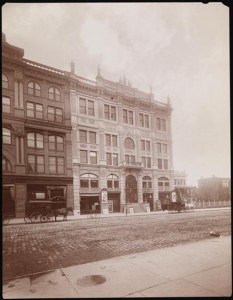 Hammerstein built dozens of rowhouses for prospective residents, but his real vision was the Harlem Opera House (at right), constructed in 1889 and located at 207 West 125th Street, on the other side of the street from the Hotel Winthrop (later the Hotel Theresa).
Hammerstein built dozens of rowhouses for prospective residents, but his real vision was the Harlem Opera House (at right), constructed in 1889 and located at 207 West 125th Street, on the other side of the street from the Hotel Winthrop (later the Hotel Theresa).
For a time, it really did just showcase operatic productions, of both the severe and light varieties. According to author Jonathan Gill, “Hammerstein had a broad vision of what uptown theatergoers wanted, and he produced both popular and genteel drama and opera in English translation, an experiment that proved attractive to audiences who were willing to pay up to $2.50 a ticket.”
Famous stars were drawn here from the stages of Herald Square. For instance, Edwin Booth performed Shakespeare here in 1889, a few years before his death. Lillian Russell, a favorite of the New York press, performed the show ‘An American Beauty’ here in March 1897.
The Opera House helped create a miniature theater district here along 125th Street. Hammerstein himself built the Columbus Theatre the following year, bringing more popular fare — namely, vaudeville. Soon the street would become one of New York’s great centers of burlesque entertainment. Many years later, Hurtig & Seamon’s New Burlesque Theater would open a couple doors down from the opera house, later changing its name to the Apollo Theatre.
Hammerstein, however, could not make the Harlem Opera House a financial success, and he was soon lured downtown to build his most renown theaters (and places that would later inspire his grandson Oscar Hammerstein II.) The Harlem Opera House was sold and transformed into a more traditional vaudeville house. By the 1930s, to compete with the thriving amateur nights over at the Apollo, the Harlem Opera House had its own amateur nights. Its most notable discovery is one of the greatest names in music — Ella Fitzgerald.
Below: Another view of the Opera House, here as Proctor’s Opera House, courtesy NYHS. The balconies to the left belong to the Winthrop Hotel — compare this picture to the Winthrop photo here — to be replaced in a few years by the Theresa.
The Opera House was torn down in 1959. Surprisingly, it appears there was the possibility of a new opera house in Harlem being built in the late 1960s, under the guidance of Gian Carlo Menotti, but that never panned out. However, the operatic tradition lives on today with the Harlem Opera Theater, founded in 2001.
Below: You can still find the Harlem Opera House in Harlem — on the walls of the 125th subway station, in mosaic form!

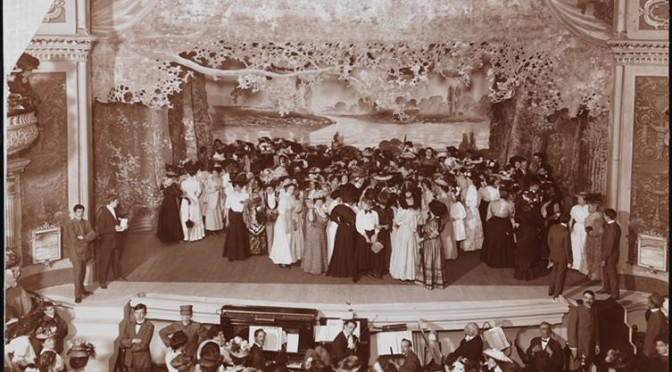
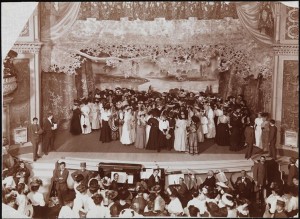
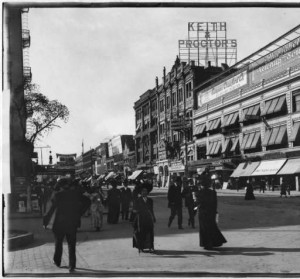
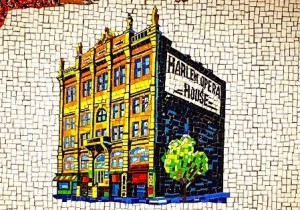
1 reply on “Harlem on a high note: The grand Harlem Opera House”
What a helpful posting this was! Thank you, Bowery Boys. Our Subway Art Tour Four [https://walkaboutny.com/the-tours/subway-art-tours/subway-art-tour-four/] includes the subway art at 125th St. & Lenox Ave. where the glass mosaic of the Harlem Opera House can be seen on the Downtown side. And you have used a photo of it.